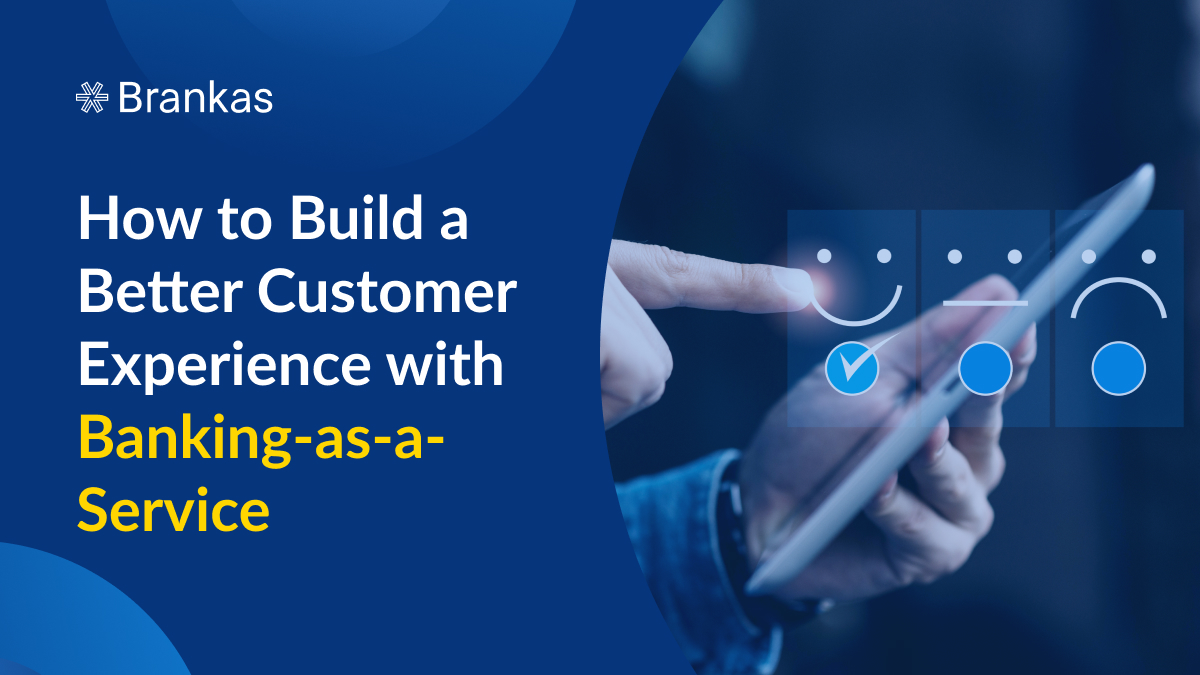Customers are constantly seeking ways to enhance the quality of their lives, which means convenience and trust are their priorities. Businesses must constantly innovate to provide value and keep up with evolving customer expectations. This rings true in the financial sector, where customer experience (CX) is no longer just a buzzword. It has become a defining factor or standard in how companies conduct business.
CX refers to customers' overall perception of a brand based on their interactions, from the first point of contact to after-sales support. Enter Banking-as-a-Service (BaaS)—a model that enables non-bank companies to seamlessly integrate financial products and services into their existing platforms. How does BaaS make the customer experience better?
This blog will explore how to enhance customer experience with BaaS, outlining key strategies that help deliver faster, more personalized, and seamless CX.
What is Customer Experience (CX) in Financial Services?
Customer experience refers to the impression customers have of a business based on their interactions across various touchpoints. CX is crucial in the financial ecosystem because customers interact with banking and financial services daily—whether it’s making payments or securing loans. Poor CX can be frustrating and drive customers away.
For example, imagine a small business owner applying for a loan to fund their business venture. They visit a traditional bank, where the loan approval process is tedious, requiring extensive paperwork and a long waiting period. They have no idea when or even if they will receive the funds they need. Throughout their experience, there is little transparency, and updates are few and far between. This negative CX leaves the business owner or borrower feeling discouraged.
But with the rise of digital banking and embedded financial services, customers now expect speed, convenience, and seamless access. These are all made possible by Banking-as-a-Service. (BaaS).
Why You Should Care About CX
If you’re a non-bank business, how you integrate financial services into your offerings determines whether you gain a loyal customer or not. Nothing can damage your reputation faster than an irate customer. Here’s why enhancing customer experience with BaaS should be your top concern:
1. CX Directly Impacts Customer Retention and Loyalty
Customers today expect frictionless transactions—whether they’re making a purchase, subscribing to a service, or applying for credit. Poor CX, such as slow checkout processes, complicated payment options, or rigid financing solutions, can push customers away.
2. Convenience Equals Sales
If you want to drive revenue growth, you need to make payment easier and more secure. Integrating one-click payments, automatic fund disbursement, or digital wallets removes unnecessary barriers to conversion. A smoother transaction process means fewer abandoned carts, higher purchase completion rates, and, therefore, increased revenue for your business.
3. Competitive Edge
In a saturated market, superior CX can push consumers to choose your platform over your competitor’s. Think of Uber’s seamless in-app payments or Amazon’s “Buy Now, Pay Later” options. If you don’t offer the same level of ease and convenience, customers will go to businesses that do. This is a missed opportunity that BaaS could easily address.

What is Banking-as-a-Service?
Non-bank businesses can enhance customer experience with BaaS even without the necessary technologies and systems internally. At its core, BaaS allows non-bank companies, such as e-commerce stores and retailers, to integrate baking services directly into their platforms. With BaaS, businesses can now “plug in” banking capabilities using APIs provided by licensed providers and financial institutions.
BaaS is enabled by open banking in financial services, where traditional banks share their infrastructure with third parties via secure APIs. This allows businesses to embed financial solutions without doing a complete overhaul of their existing systems.
Real-World Examples of BaaS
• E-commerce: A fashion retailer can add financing options at checkout using BaaS, allowing customers to split payments over time. This boosts sales while making products more affordable and accessible to customers who cannot pay full price instantly.
• Ride-Hailing and Gig Economy: A food delivery app can offer instant payouts to drivers instead of making them wait days for bank transfers to push through.
• Subscription Services: A streaming platform can provide localized payment methods without setting up separate banking accounts in different countries.
How BaaS Works
Essentially, BaaS works under the following mechanics:
Partnerships
BaaS starts with a partnership between your company and a BaaS provider. This provider uses its strategic ties with prominent banks and financial institutions to give you access to a variety of financial services, including local currency accounts and card issuance.
API Integration
You can directly embed BaaS by utilizing the provider’s various APIs, such as payment APIs or open finance platforms. Your development team incorporates these into your existing systems, enabling your company to communicate securely with the BaaS provider’s infrastructure.
Customization and Configuration
With BaaS, you can tailor financial services to your brand, business, and consumer requirements. For example, you can build branded payment cards or a user experience that complements your website.
Customer Onboarding
Customers can create accounts, link their current business bank accounts, or deposit funds straight into your financial products, such as a digital wallet. The BaaS provider also handles the Know Your Customer (KYC) verification process, ensuring compliance with anti-money laundering (AML) and other regulatory standards. By leveraging the BaaS provider’s KYC processes, you may improve your clients' onboarding experience while ensuring the greatest levels of security and compliance.
Regulatory Compliance
In addition to KYC, the BaaS provider manages the larger regulatory and compliance aspects of financial services, ensuring that your firm operates within legal bounds both worldwide and locally. This decreases the likelihood of noncompliance with standards such as the Payment Card Industry Data Security Standard (PCI DSS) or the General Data Protection Regulation (GDPR), which can be difficult for organizations as they extend operations across borders.
Transaction Processing
Once your customers are onboarded, they can begin using the financial services you provide. Every transaction, whether a transfer or an account management action, is routed through the BaaS provider’s systems. The provider has implemented security steps to ensure that transactions are secure.

Enhancing Customer Experience with BaaS
Businesses can leverage BaaS without the need for significant capital investment or expensive overhead costs. Here are key strategies on how to build a better customer experience with BaaS through your service provider:
1. Seamless Embedded Payments
Customers expect fast and effortless transactions. Businesses that integrate BaaS-powered embedded payments can provide frictionless checkouts without diverting users to external systems. For example, ride-hailing applications such as Grab let customers pay immediately within the app using digital wallets or linked bank accounts, eliminating the need for manual payments.
2. Personalized Financial Services
BaaS lets businesses create financial services tailored to the needs and preferences of their customers, which is the whole point of open banking solutions. Companies can now use customer data to provide personalized products and services, such as lending options, savings accounts, or investment plans. For instance, an e-commerce store can offer “Buy Now, Pay Later” options based on a shopper’s purchase history.
3. Multi-Currency and Cross-Border Payments
For companies with overseas customers, BaaS facilitates multi-currency payments and eliminates conversion complications. For example, global e-commerce companies such as Shopify use embedded banking to let users pay in their preferred currency.
4. Enhanced Security and Fraud Prevention
Trust is vital to financial transactions. BaaS integrates AI-driven fraud detection, biometric authentication, and encryption to safeguard users and their data. This ensures that customers have a secure banking experience.
5. Optimizing Digital Platforms
A smooth and efficient digital platform is non-negotiable in BaaS. Customers expect fast, intuitive, and hassle-free experiences. If your app frequently crashes or has technical glitches, customers will abandon it. Conduct regular updates, testing, and real-time monitoring to prevent disruptions. Use clear navigation, easy-to-read fonts, and straightforward layouts so users can complete their transactions with minimal steps. Lastly, ensure that embedded features work smoothly within your platform.
6. Customer Support
Financial transactions are sensitive in nature. Customers need fast, responsive, and consistent support, especially when they have concerns about their money. Implement AI-driven chatbots and automated self-service portals to handle common banking-related inquiries, such as balance checks or payment tracking. Ensure that your business can be contacted across multiple channels at all times, be it live chat, email, social media, or phone.

Improve Customer Experience with BaaS
Enhancing customer experience (CX) with Banking-as-a-Service (BaaS) is key to building seamless, efficient, and customer-friendly financial interactions. Whether you’re streamlining payments, offering personalized banking services, or enabling instant payouts, BaaS helps you stay ahead of customer expectations.
Brankas empowers businesses with open banking and BaaS solutions to streamline operations without compromising customer experience.
Ready to take your CX to the next level? Contact us today to get started.
